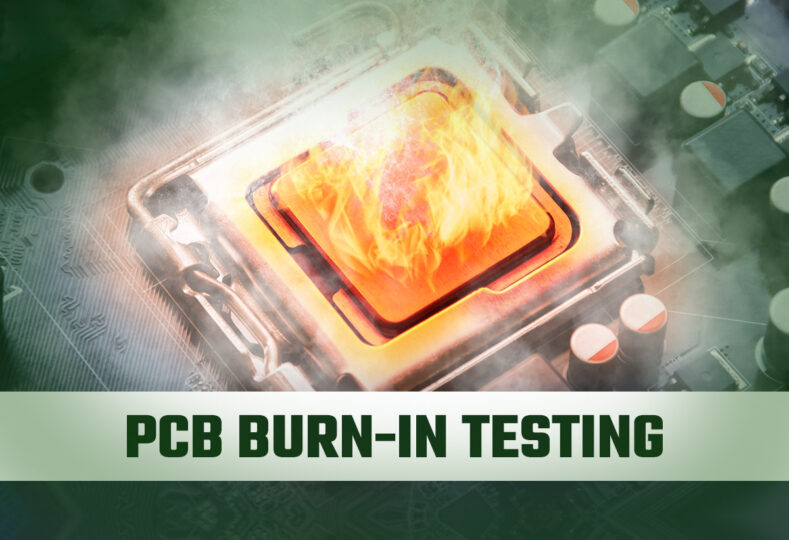Understanding the PCB Burn-in Testing Process in PCB Manufacturing!

Given the crucial role that printed circuit boards play in the working of appliances, many of them mission-critical, robust testing of PCBs is a key pre-requisite. One such testing method is the PCB burn-in testing also known as stress test, that checks for potential defects early as also helps establish load capacity. The objective of this test is to identify & replace any failed components, early.
In common parlance, burn-in testing detects “infant mortality” or early failure under load. It is thus an integral testing mechanism that helps test load capacity. It also assesses product performance under real world conditions. Its importance particularly in industries such as military, medical, aerospace and more, cannot be overstated.
Broadly burn-in testing involves running the products at elevated voltage and temperature levels as also under power cycling conditions. It could involve:
- An operating electrical cycle over a time period of 48-168 hours.
- Thermal cycle with temperatures of 125 degree Celsius for 160 hours.
- Environmental stress screening.
With Burn-in testing you can:
- Detect potential failures. The testing therefore plays a huge role in ensuring product reliability.
- Find out the time to failure. Essentially the testing helps you determine how long a component will last.
- Measure the mean time between failures.
- It helps identify defects including but not limited to metallization failures, dielectric failures, conductor failures and electro migration.
- With manufacturers being able to reduce their returns having found the defects early, it goes a long way in saving time, money & effort.
- It reduces the huge cost associated with post-production failures including the cost involved with the loss of reputation.
How is Burn-in Testing done?
While the advantages of burn-in testing are immense, how exactly is it done? Essentially, burn-in testing involves operating the product under extremes of temperature & high voltage range for several days so as to detect any defects. During the process, the PCB undergoes electrical as well as thermal testing. Firstly, electric current is passed through the board from between 40-160 hours. The boards are also exposed to temperatures of upto 125 degrees Celsius for 160 hours or longer.
The board that is used for the burn-in test is made out of FR4 flame retardant material. However, when the temperature of the board exceeds 125 degrees Celsius, boards made of ceramic & polyamide are used.
An important aspect to note is that if the board is put to more stress than it is designed to withstand, it can reduce the longevity of the board. Therefore, while it is important to adequately check the board, in case few or no flaws are discovered the test limit can be lowered.
Types of PCB Burn-In testing
The two types of burn-in tests include:
- Static Burn-in Testing – In such testing the PCB is not in operational mode when it is subjected to high voltage & temperature. This, thus, is a simpler procedure.
- Dynamic Testing – In this testing the PCB is subject to high voltage & temperature while it is in operational mode. This is largely used for complex PCBs.
As a thumb rule, burn-in is best done at the component level. This is because at that level the cost of testing as well as replacing parts is the lowest. With different components having different limits, it is difficult to conduct burn-in for the board or assembly. This is not to say that it cannot be done, as it helps bring to light issues such as dry solder joints as well as issues with contact.
To sum up
To have the printed circuit board fail a burn-in test is to avoid costly errors at a later date. Especially for mission critical products where you cannot afford to have any failure rate, the importance of a burn-in test cannot be overstated. You sure want to go with a manufacturer who follows the highest protocols when manufacturing the board and also the most stringent measures while testing it. It is important however for the electronic contract manufacturer to follow the specified parameters in the testing as you do not want to subject the electronics to more stress than they are rated for and reduce their lifespan.
Technotronix is an ISO 9001:2015 certified company who provides comprehensive PCB manufacturing services, including specialized support, testing, and multi-functional features. Our commitment to consistent quality and rapid turnaround times makes us a go-to choice for customers seeking a one-stop-shop for all their PCB requirements.
If you have any requirements regarding our PCB manufacturing or need urgent assistance, contact us at [email protected] or call us on 714/630-9200.






